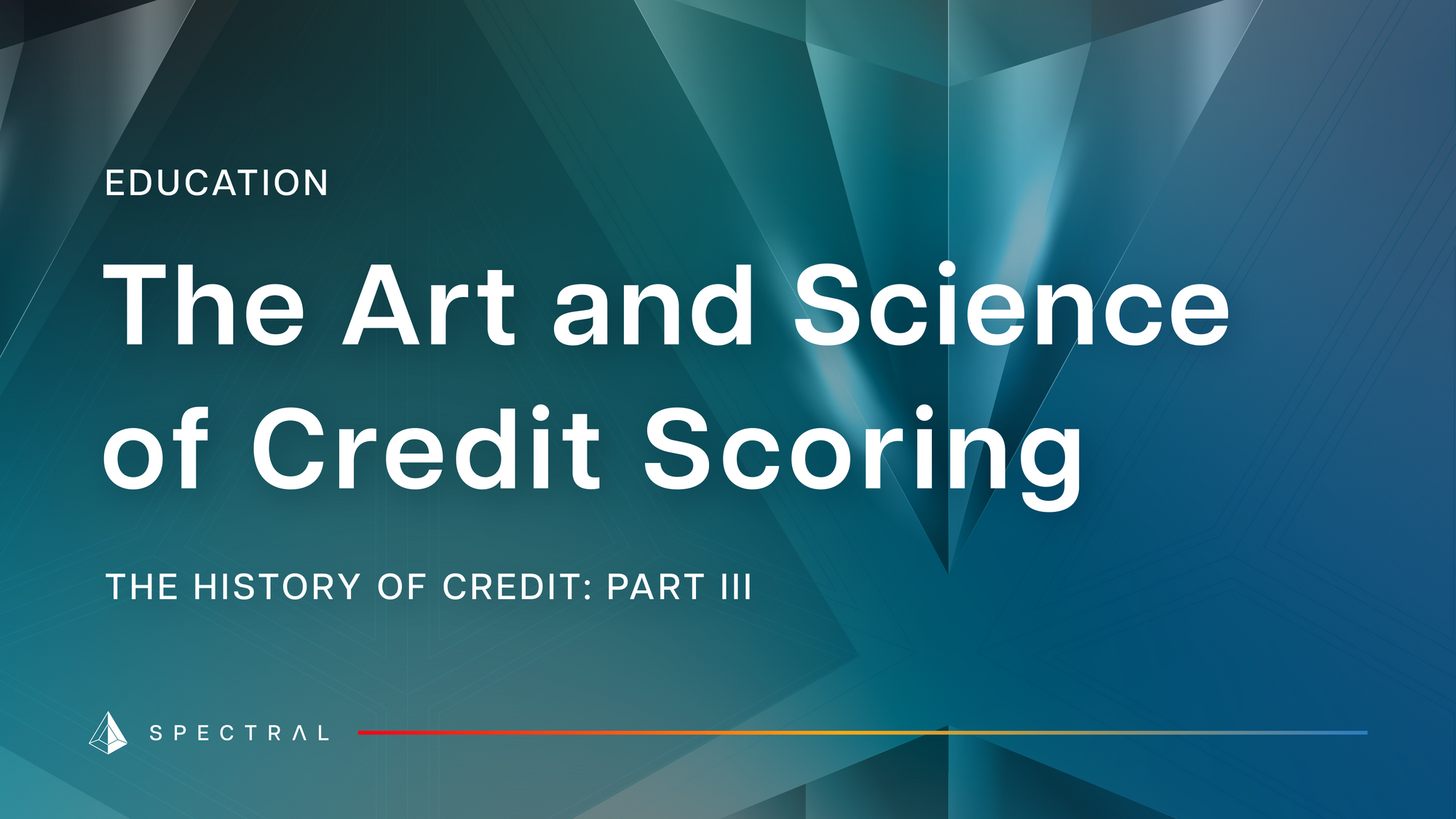Credit as a Zero-Sum Game (The First 3000 Years)
Civilization has gradually reframed borrowing from a zero-sum game of obligation to a mutually beneficial agreement. The first in a three-part series dedicated to the history of credit, credit intelligence, and credit modeling.

Decentralized Finance (DeFi) offers a historically unprecedented opportunity for overhauling our existing credit infrastructure. To get there, it’s important to understand how our current lending institutions and the credit assessment infrastructure evolved. This is the first in a series of articles on the subject, dedicated to the history of credit. The second in the series will cover credit intelligence and the final one will cover credit scoring.


Debt is an obligation and historically carries a heavy burden. Debt is binary. Either you repay your debt or you face the consequences. Credit is different, explains Raymond Anderson in Credit Intelligence & Modelling. Credit is based on trust. It is a negotiation, a balance of opportunity and cost; and in approaching lending as offering credit, a lender acknowledges risk and attempts to price it in. This change in perspective introduces the idea of assessing a borrower’s creditworthiness. And with creditworthiness, lending becomes a marketplace, as lenders can shop around, prices fluctuate, and profits can be made. In fact, if there’s a single thread to be plucked from the entire history of lending and borrowing, it is the change of perspective from lending as creating an obligation to seeing lending as placing trust in another and pricing it in.

Early approaches to lending and borrowing
During the afterlife, Ancient Egyptians weighed their hearts against a feather. Souls heavy with sin were devoured by crocodiles. Taxation and economics were determined by fluctuations in flood levels.
The priestly class used “Nilometers,” buildings that measured and collected flood records and, according to the New Yorker’s John Lanchester, were the source of much of their authority and mythology. Banking existed but banks didn’t loan money. Instead, Egyptian moneylending was an interpersonal activity, with interest fixed at 12 percent. Repayment was an obligation. Creditworthiness assessment was a matter of knocking on a neighbor’s door.
Later, particularly as Islam–which prohibited charging interest–spread through the region, community fundraising clubs emerged called gameyas, a practice that continues to this day. Households paid into a community pool, with funds distributed on a rotating or random basis to a lucky winner. Usury laws and bans were partly a means to protect governments. “Most ancients believed one could only prosper at the expense of others,” Anderson says, “they had no concept of economic wealth creation.” He cites David Graeber who identified a reoccurring pattern of “public indebtedness followed by revolt; or exodus into the hinterland, regroup, and invasion.” The Rosetta Stone mentions an Egyptian national debt cancellation and the Code of Hammurabi capped interest rates at 33 percent. The first sovereign default occurred when two of the thirteen members of the Delian League (a confederation of Aegean city-states) failed to make payments, forcing them to relocate the treasury to Athens.
Penalties for non-payment of debt were harsh in Greece and Rome. The Athenian Draco (from whom we derive the word ‘Draconian’) allowed offering “a person’s body as security for debt and non-payment could mean slavery for self and family.” In early Rome, nonpayment in 30 days meant torture with execution, dismemberment, or sale into slavery at 60 days.
In early Rome, nonpayment in 30 days meant torture with execution, dismemberment, or sale into slavery at 60 days.
Gradually the Republic and later the Empire relaxed laws, balancing the risk of insurrection with the demands of an entrenched elite, with Emperor Augustus briefly allowing voluntary bankruptcy though restricting it to “legitimate causes” such as shipwrecks and fires. Fear of insurrection remained the primary motivation for debt forgiveness, although some retroactive consideration for what might have caused a default was beginning to creep in.
Lending may predate literature. Four thousand years ago, clay tablet proto-ledgers kept records of wages paid and goods received in Mesopotamia, including notes warning of poor-quality copper ingots and outstanding balances.

A thousand years from judgment to risk mitigation
Christian morality was the foundation for most lending and borrowing in Europe, and in applying a moral code to “consumption” helped introduce ideas and legislation that would eventually lead to creditworthiness assessment, though it would be over a thousand years before a rigorous, coherent methodology would be applied.
Penalties for non-payment of debt remained harsh, with imprisonment and even execution possible for default, until the widespread adoption of bankruptcy laws in 17th century Europe and the gradual realization that “default might not be malevolent… but the fate of innocents.” Usury laws remained in place until the Renaissance. Widespread acceptance of interest came in 16th Century, according to Anderson, with changes in religious views toward usury coming in the 17th and 18th Centuries primarily from Protestant theology.
Early Christian attitudes toward lending can be traced to Greek philosophy, which distinguished between chermatiske, which is the idea that any trade for profit is devoid of virtue, and oikonomikos, which was household trade essential for societal functioning. With this moral code came prohibitions on charging interest for personal lending, which was still considered immoral for creating value from nothing. Attitudes toward borrowing were beginning to soften but predicated on moral value. “It might be okay to buy seeds to plant, but not the shoes worn while planting.” The Church became a major source of credit, lending money in exchange for land and later charging parishioners a form of rent in exchange for using that land.
Elsewhere in the world, China had a well-developed banking system by the Medieval period in Europe. Promissory banknotes appeared in the Song Dynasty (10th century) and merchants' guilds pooled funds to sponsor trade ships. As early as the Tang Dynasty (7th century), there were laws protecting borrowers from predatory lending, prohibiting loans to children, and by the Song Dynasty, there were caps on interest rates, a vouching system in place requiring five guarantees for a “young crop loan” from the local authorities, with “the amount of the money depend[ing] on the financial capability and the number of the guarantees.” A network of middlemen helped facilitate the movement of capital, debt relief was often granted during natural disasters by the government, and repayment was partially guaranteed with the threat of losing face or ghostly reciprocity.
Other forms of lending were evolving. In Europe, the Catholic Church often made interest-free loans to the poor. Real estate became much more fungible of an asset as “a new need for credit arose–nobility looking to finance their crusades or pilgrimages.” This led to the proliferation of secured loans. A gage, the predecessor to a mortgage, was a pledge that “transferred control but not ownership,” there were two types, vifgage (a life pledge) and morgage (a death pledge), which in turn spawned institutional frameworks responsible for sustaining them and dealing with disputes.
On a smaller scale, personal loans were extended and secured with small goods and items at pawnbrokers, who had existed since the 5th century in China, spreading the idea of using property as collateral. Later, shops began using open accounts, offering customers permission to buy goods on credit. Here, creditworthiness was assessed from a combination of “experience of past dealings, the customers’ reputation (local gossip) and standing in the community.” Prices were negotiated based on the decision to pay in cash or credit and the reputation of the buyers, thus incorporating risk into their price models.
Merchant banking used to finance trade inter-regional trade and insurance began to mushroom up around trading hubs, first in 11th-century France. During the Renaissance, many Jewish communities were traditionally excluded from many occupations but free from usury restrictions. The adopted practices developed along the Silk Road such bills of exchange and developed new accounting practices to manage complex transactions necessary for international trade. Many of these banks became partnerships or family concerns to spread risk. They began lending capital to merchants and aristocrats, creating virtuous cycles as merchants sought out new markets, and occasional crashes from market volatility or mandatory loans to governments defaulting during unsuccessful military campaigns. Paying interest on loans was voluntary but news of non-payment would quickly spread and funds would dry up.
Merchant banking was so effective it effectively quintupled the demand for money between 1540 and 1600. The money supply failed to keep pace, growing a mere 63 percent, creating contractural cobwebs stretching across countries and city-states. The networks and legislative bodies that grew from this paperwork miasma created the financial infrastructure that sustained the Industrial Revolution and the subsequent explosion in consumer credit.

Feeding the Industrial Revolution
Debt was beginning to be seen as a positive force, capable of growing wealth for the lender and the borrower, provided a borrower could be trusted to pay. Trust was becoming more complicated, however, as cities and incomes were growing, and more people needed access to capital, but traditional methods of vetting borrowers were getting difficult. “Urbanization brought anonymity and open field for criminality,” writes Anderson. Whisper networks didn’t work even though merchants were often forced to rely on them.
The rapid growth of factories led to a voracious appetite for capital. “One needed to not only find markets and transport goods; but also to have means of financing the supply chain from factory to consumer,” writes Anderson. Installment loans emerged around 1700 but really accelerated with the creation of labor-saving white goods (i.e. household appliances). Bond issuances became more popular and were used to finance everything from infrastructure to war. Chattel mortgages, essentially pawnbroking where the secured item stayed with the borrower, began in the United States in the late 1800s, as did “salary lending,” what we might describe as payday lending. “Conceptually, it was a significant shift,” says Anderson, “away from the security of pawned assets/fear of draconian penalties to that provided by future income.”
At first, “most credit was to finance trade, with a smattering of pianos, home furnishings, sewing machines, and farm equipment. Real growth came in the 20th century with its extension to motor vehicles, home loans, student loans, and the growth of revolving credit from stores, banks, and credit card companies.” Capital efficiency kicked into overdrive and the enormous fortunes created by all these new industries were pumped back into the economy and offered to consumers, creating a virtuous cycle of consumption, production, and investment, at least when economies were on the upswing, volatility also increased creating a familiar boom and bust cycle that in turn contracted or expanded access to cheap capital.
Psychologically, the last vestiges of shame dropped away from personal debt. Creditworthiness became an important part of upward mobility and maintaining a home. Identification and information gathering in an attempt to understand a potential borrower (or track down a delinquent debt) became extremely important.
Creditworthiness as Data Science
Blockchain technologies have revolutionary potential, but their basic structure, enabling trustless peer-to-peer payments, creates enormous problems for even basic creditworthiness assessment. DeFi has essentially ignored the problem, and most DeFi loan providers will only make fully collateralized loans, which seriously restricts the amount of lending that can occur and prevents the financial blossoming and wealth generation that took place between the Renaissance and the Modern Age.
We will dive into the specific details of the two components of scientific creditworthiness assessment, credit intelligence and credit scoring that evolved between the 19th and 21st centuries in our next two essays, and learn how Spectral Finance’s MACRO Score and its vision for creating the DeFi’s creditworthiness assessment infrastructure promises to bring the capital efficiency and access that characterizes the history of credit to decentralized finance and beyond.
This series wouldn’t have been possible without several conversations with Raymond Anderson, author of Credit Intelligence & Modelling.
Sources:
Anderson, R. (2018, March 9). Medieval lending: The Morgage and Vifgage in Norman England. LinkedIn. Retrieved October 27, 2022, from https://www.linkedin.com/pulse/lif-let-mort-story-mortgage-raymond-anderson/
Anderson, R. A. (2022). Credit Intelligence & modelling many paths through the Forest of credit rating and scoring. Oxford University Press.
Bowman, J. (2018, October 25). The Delian default. Classical Wisdom Weekly. Retrieved October 27, 2022, from https://classicalwisdom.com/politics/economics/delian-default/
Editors, T. (2016, May). The world's oldest writing. Archaeology Magazine. Retrieved October 27, 2022, from https://www.archaeology.org/issues/213-1605/features/4326-cuneiform-the-world-s-oldest-writing
François Lerouxel, M. R. G. (2013, October 12). The private credit market, the Bibliotheke Enkteseon, and public services in Roman Egypt. Cairn International Edition. Retrieved October 27, 2022, from https://www.cairn-int.info/article-E_ANNA_674_0943--the-private-credit-market-the-bibliothek.htm
Lanchester, J. (2014, July 28). Money talks. The New Yorker. Retrieved October 27, 2022, from http://www.newyorker.com/magazine/2014/08/04/money-talks-6
Tucker, N. (2021, November 22). It's as if it was written in...clay. for 4,200 years. It's As If It Was Written in...Clay. For 4,200 Years. | Library of Congress Blog. Retrieved October 27, 2022, from https://blogs.loc.gov/loc/2021/11/its-as-if-it-was-written-in-clay-for-4200-years/#
Zhou, J., Wang, R., Zhou, J., & Zhao, Y. (2017). Theory and practice on lending risk control by the government in the song dynasty. Emerging Markets Finance and Trade, 53(4), 986–1000. https://doi.org/10.1080/1540496x.2016.1256196





